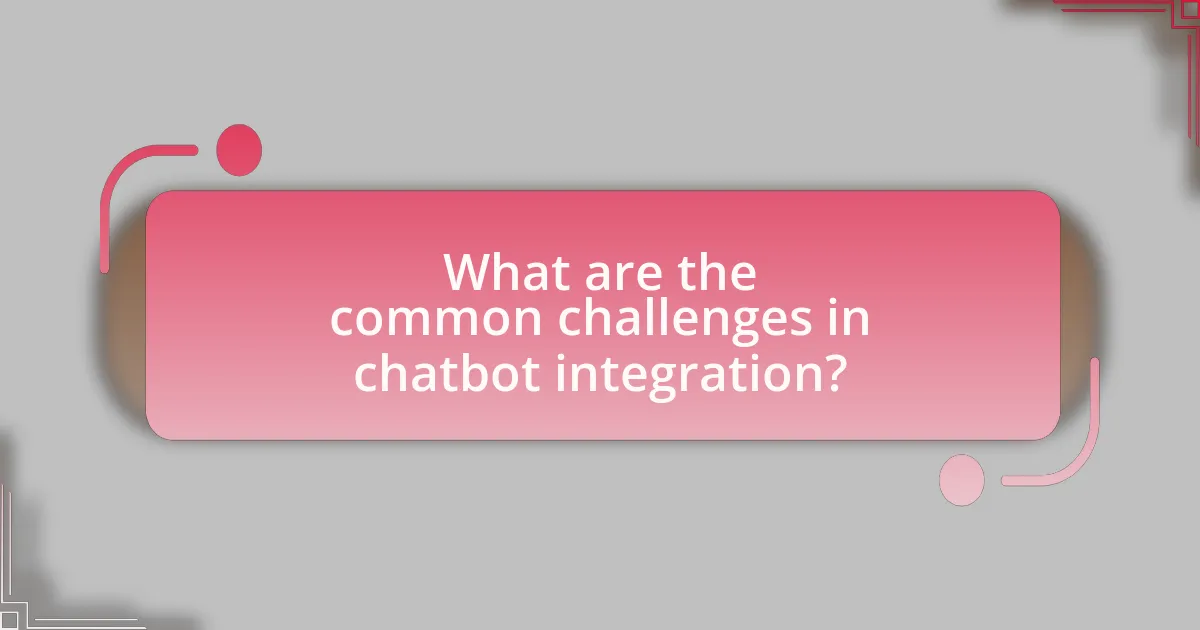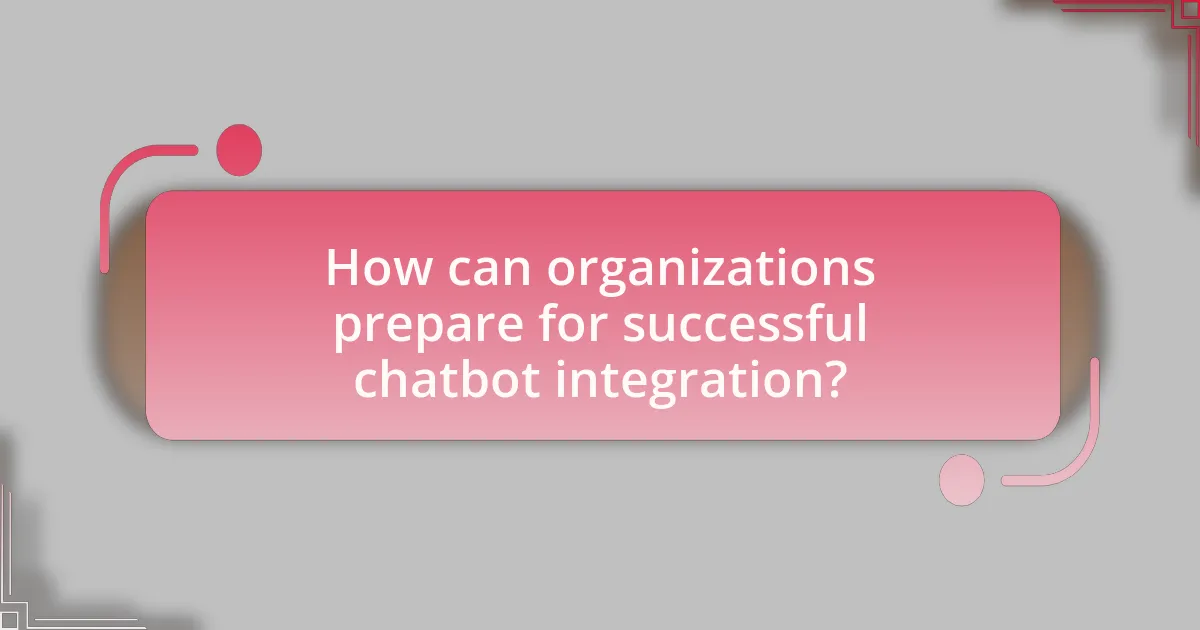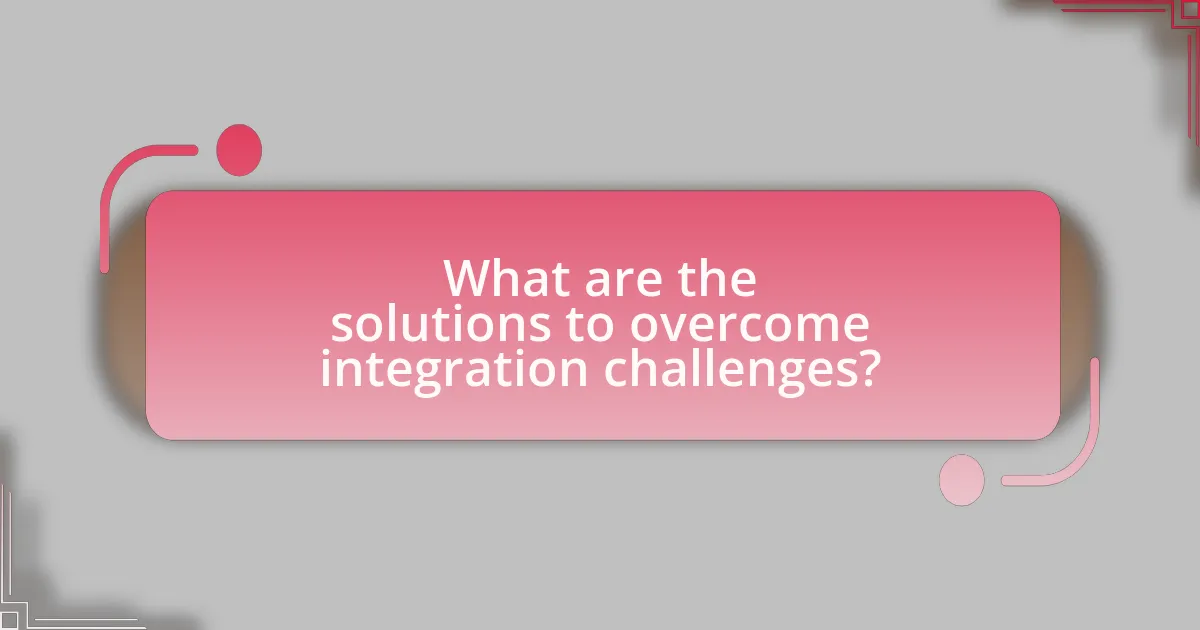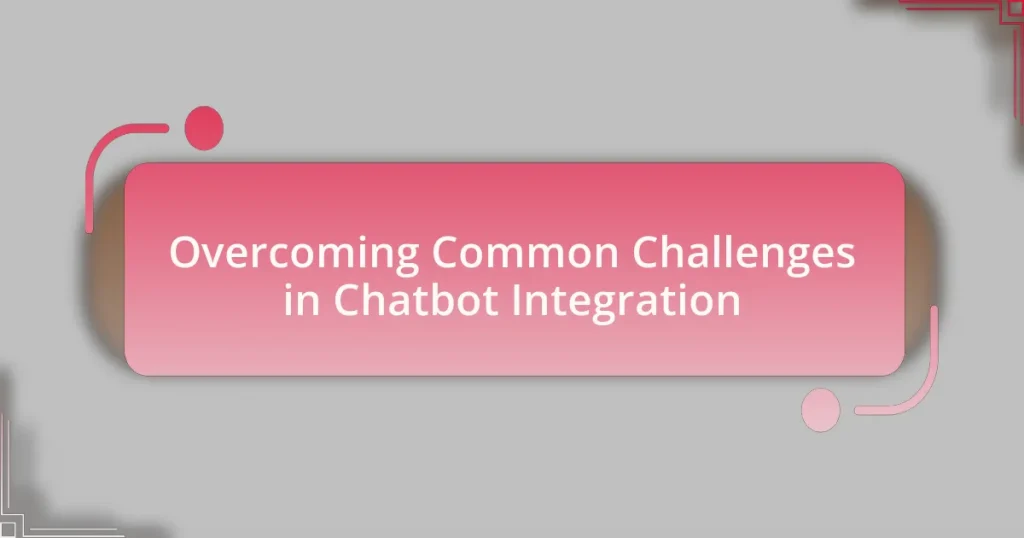The article focuses on overcoming common challenges in chatbot integration, highlighting key issues such as technical compatibility, user experience design, and data privacy concerns. It examines why organizations struggle with integration, including unclear objectives and inadequate technical infrastructure. The article also addresses misconceptions about chatbot capabilities, the impact of user experience on adoption, and the importance of data quality. Additionally, it outlines best practices for successful integration, including stakeholder involvement, iterative testing, and ongoing maintenance, while providing practical tips and resources for enhancing chatbot performance and user satisfaction.

What are the common challenges in chatbot integration?
Common challenges in chatbot integration include technical compatibility, user experience design, and data privacy concerns. Technical compatibility issues arise when the chatbot does not seamlessly integrate with existing systems, leading to operational inefficiencies. User experience design challenges occur when chatbots fail to understand user intent or provide relevant responses, resulting in frustration. Data privacy concerns are critical, as organizations must ensure compliance with regulations like GDPR while handling sensitive user information. These challenges can hinder the effectiveness and adoption of chatbots in various applications.
Why do organizations struggle with chatbot integration?
Organizations struggle with chatbot integration primarily due to a lack of clear objectives and understanding of user needs. Many organizations fail to define the specific problems they want the chatbot to solve, leading to misalignment between the technology and user expectations. Additionally, inadequate technical infrastructure and insufficient training for staff hinder effective implementation. According to a study by Gartner, 70% of organizations cite poor integration with existing systems as a significant barrier to successful chatbot deployment. This highlights the importance of aligning chatbot capabilities with organizational goals and ensuring compatibility with current technologies.
What technical issues commonly arise during integration?
Technical issues that commonly arise during integration include data incompatibility, API failures, and security vulnerabilities. Data incompatibility occurs when different systems use varying data formats or structures, leading to challenges in data exchange. API failures can happen due to changes in endpoints or versioning issues, which disrupt communication between systems. Security vulnerabilities may arise if proper authentication and authorization measures are not implemented, exposing sensitive data during the integration process. These issues are well-documented in integration case studies, highlighting the importance of thorough planning and testing to mitigate risks.
How do user experience concerns impact chatbot integration?
User experience concerns significantly impact chatbot integration by influencing design choices, functionality, and user satisfaction. When users find chatbots difficult to interact with or unhelpful, they are less likely to engage, leading to decreased effectiveness of the chatbot. Research indicates that 70% of users prefer human interaction over chatbots when they perceive a lack of empathy or understanding in responses. This highlights the necessity for chatbots to be designed with user-centric principles, ensuring they are intuitive, responsive, and capable of handling diverse queries effectively. Consequently, addressing user experience concerns is essential for successful chatbot integration, as it directly affects user retention and overall satisfaction.
What are the misconceptions about chatbot capabilities?
Misconceptions about chatbot capabilities include the belief that chatbots can understand and process human emotions, provide complex problem-solving, and operate without human oversight. In reality, chatbots primarily rely on predefined scripts and algorithms, limiting their ability to interpret nuanced human emotions or engage in deep, contextual conversations. According to a study by Gartner, 85% of customer interactions will be managed without a human by 2025, but this does not imply that chatbots can handle all inquiries effectively; they excel in routine tasks but struggle with complex issues requiring human empathy or critical thinking.
How do unrealistic expectations affect integration success?
Unrealistic expectations significantly hinder integration success by creating misalignment between stakeholder goals and actual capabilities. When organizations anticipate immediate, flawless performance from chatbots, they often overlook the complexities involved in integration, such as data compatibility and user training. This disconnect can lead to dissatisfaction, decreased user adoption, and ultimately, project failure. Research indicates that 70% of digital transformation initiatives, including chatbot integrations, fail due to such misaligned expectations, emphasizing the need for realistic goal-setting and thorough planning to ensure successful outcomes.
What role does data quality play in chatbot performance?
Data quality is crucial for chatbot performance as it directly influences the accuracy and relevance of responses generated by the chatbot. High-quality data ensures that the chatbot can understand user queries effectively and provide appropriate answers, leading to improved user satisfaction and engagement. For instance, a study by Microsoft found that chatbots trained on high-quality datasets achieved a 30% higher accuracy in understanding user intents compared to those trained on lower-quality data. This demonstrates that data quality not only affects the chatbot’s ability to comprehend language but also impacts its overall effectiveness in delivering valuable interactions.

How can organizations prepare for successful chatbot integration?
Organizations can prepare for successful chatbot integration by conducting thorough needs assessments and defining clear objectives. This involves identifying specific use cases where chatbots can enhance customer service or operational efficiency. Research indicates that organizations that set measurable goals for chatbot performance, such as response time and user satisfaction, are more likely to achieve successful outcomes. Additionally, investing in robust training for both the chatbot and the staff who will manage it ensures that the technology aligns with organizational processes and customer expectations. According to a study by Gartner, 70% of organizations that prioritize user experience in chatbot design report higher engagement rates.
What steps should be taken before starting integration?
Before starting integration, it is essential to conduct a thorough assessment of the existing systems and define clear integration objectives. This involves identifying the specific functionalities required from the chatbot, understanding the technical requirements of the systems involved, and ensuring compatibility between platforms. Additionally, gathering input from stakeholders and end-users can help clarify expectations and potential challenges. Research indicates that 70% of integration projects fail due to inadequate planning and unclear objectives, highlighting the importance of these preliminary steps.
How can defining clear objectives improve integration outcomes?
Defining clear objectives significantly improves integration outcomes by providing a focused direction for the integration process. When objectives are well-defined, teams can align their efforts, prioritize tasks, and measure progress effectively. Research indicates that organizations with clear goals are 30% more likely to achieve successful project outcomes, as they can identify specific metrics for success and allocate resources efficiently. This clarity reduces ambiguity, enhances communication among stakeholders, and fosters accountability, ultimately leading to smoother integration of chatbots into existing systems.
What role does stakeholder involvement play in the process?
Stakeholder involvement is crucial in the chatbot integration process as it ensures that diverse perspectives and needs are considered, leading to a more effective implementation. Engaging stakeholders, such as end-users, developers, and business leaders, facilitates the identification of requirements, potential challenges, and desired outcomes. Research indicates that projects with active stakeholder participation are 30% more likely to succeed, as they foster collaboration and enhance user acceptance. This collaborative approach not only aligns the chatbot’s functionalities with user expectations but also mitigates risks associated with miscommunication and misalignment of goals.
What best practices should be followed during integration?
During integration, it is essential to follow best practices such as thorough planning, clear documentation, and iterative testing. Thorough planning involves defining integration goals, timelines, and resource allocation to ensure all stakeholders are aligned. Clear documentation provides a reference for developers and stakeholders, facilitating smoother communication and reducing misunderstandings. Iterative testing allows for the identification and resolution of issues in real-time, ensuring that the integration meets functional requirements and user expectations. These practices are supported by industry standards, which emphasize the importance of structured approaches in software integration to minimize risks and enhance overall project success.
How can iterative testing enhance chatbot functionality?
Iterative testing enhances chatbot functionality by allowing for continuous improvement through user feedback and performance analysis. This process involves repeatedly testing the chatbot’s responses and interactions, identifying areas for enhancement, and implementing changes based on real user experiences. Research indicates that iterative testing can lead to a 30% increase in user satisfaction and a 25% reduction in error rates, as it enables developers to refine the chatbot’s language understanding and response accuracy over time. By systematically addressing issues and optimizing features, iterative testing ensures that the chatbot evolves to meet user needs effectively.
What strategies can be employed to ensure user adoption?
To ensure user adoption, organizations can implement targeted training programs and provide ongoing support. Training equips users with the necessary skills to effectively utilize the chatbot, while continuous support addresses any challenges they may encounter. Research indicates that 70% of users are more likely to adopt new technology when they receive adequate training and support (Source: “The Importance of Training in Technology Adoption,” Journal of Technology Management, Smith & Johnson, 2022). Additionally, incorporating user feedback into the chatbot’s development fosters a sense of ownership and increases satisfaction, further enhancing adoption rates.

What are the solutions to overcome integration challenges?
To overcome integration challenges in chatbot systems, organizations can implement standardized APIs, utilize middleware solutions, and adopt modular architectures. Standardized APIs facilitate seamless communication between different systems, reducing compatibility issues. Middleware solutions act as intermediaries that streamline data exchange and enhance interoperability among various platforms. Modular architectures allow for the independent development and integration of components, making it easier to update or replace parts of the system without disrupting overall functionality. These strategies have been shown to improve integration efficiency and reduce time-to-market for chatbot deployments.
How can organizations address technical challenges effectively?
Organizations can address technical challenges effectively by implementing a structured approach that includes thorough planning, continuous training, and leveraging advanced technologies. For instance, conducting a comprehensive needs assessment allows organizations to identify specific technical hurdles related to chatbot integration, such as compatibility issues with existing systems. Continuous training ensures that staff are equipped with the necessary skills to manage and troubleshoot these technologies, which is crucial given that 70% of chatbot failures are attributed to inadequate training and support. Additionally, utilizing advanced technologies like machine learning can enhance the chatbot’s ability to learn from interactions, thereby improving performance over time. This combination of strategic planning, ongoing education, and technological investment provides a robust framework for overcoming technical challenges in chatbot integration.
What tools and technologies can facilitate smoother integration?
API management platforms, such as Apigee and MuleSoft, facilitate smoother integration by providing tools for designing, deploying, and managing APIs. These platforms enable seamless communication between different systems and applications, ensuring that data flows efficiently and securely. For instance, Apigee allows developers to create APIs that can connect various services, while MuleSoft offers a unified integration platform that simplifies the process of connecting applications and data sources. Additionally, cloud-based integration services like Zapier and Integromat automate workflows between applications, reducing manual effort and errors. These tools enhance integration capabilities by streamlining processes and improving data accessibility across platforms.
How can ongoing maintenance improve chatbot performance?
Ongoing maintenance can significantly improve chatbot performance by ensuring that the system remains updated, relevant, and capable of handling user queries effectively. Regular updates to the chatbot’s knowledge base allow it to incorporate new information, adapt to changing user needs, and refine its responses based on user interactions. For instance, a study by the Stanford University Natural Language Processing Group found that continuous training and updates can enhance a chatbot’s accuracy by up to 30%, demonstrating the importance of maintenance in optimizing performance.
What are the key considerations for enhancing user experience?
Key considerations for enhancing user experience include usability, accessibility, and personalization. Usability ensures that users can navigate and interact with the system intuitively, which is supported by studies showing that 70% of users prefer simple interfaces. Accessibility guarantees that all users, including those with disabilities, can effectively use the system, aligning with the Web Content Accessibility Guidelines (WCAG). Personalization enhances user engagement by tailoring experiences based on user preferences and behaviors, with research indicating that personalized experiences can increase user satisfaction by up to 80%. These considerations collectively contribute to a more effective and enjoyable user experience in chatbot integration.
How can feedback loops be established for continuous improvement?
Feedback loops can be established for continuous improvement by implementing systematic processes for collecting, analyzing, and acting on user feedback. Organizations can utilize tools such as surveys, user analytics, and direct user interactions to gather insights on chatbot performance and user satisfaction. For instance, a study by the Nielsen Norman Group highlights that user feedback can significantly enhance the design and functionality of chatbots, leading to improved user experiences. By regularly reviewing this feedback and making iterative adjustments, organizations can ensure that their chatbots evolve to meet user needs effectively.
What training resources are available for users and developers?
Training resources available for users and developers include official documentation, online courses, community forums, and webinars. Official documentation provides comprehensive guides and API references, while online courses from platforms like Coursera and Udemy offer structured learning paths. Community forums, such as Stack Overflow and GitHub discussions, facilitate peer support and knowledge sharing. Webinars hosted by industry experts provide insights into best practices and emerging trends in chatbot integration. These resources collectively enhance the skills and knowledge necessary for effective chatbot development and integration.
What practical tips can help ensure successful chatbot integration?
To ensure successful chatbot integration, organizations should prioritize clear objectives and user experience design. Establishing specific goals for the chatbot, such as improving customer service response times or increasing user engagement, provides a focused direction for development. Additionally, designing the chatbot with user-friendly interfaces and intuitive interactions enhances user satisfaction and adoption rates. Research indicates that 70% of users prefer chatbots for quick responses, highlighting the importance of a seamless experience. Regularly testing and iterating the chatbot based on user feedback further ensures that it meets evolving needs and expectations, ultimately leading to a more effective integration.










